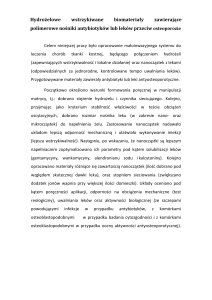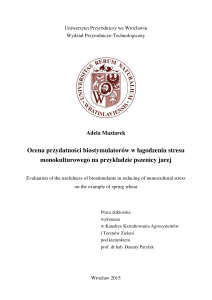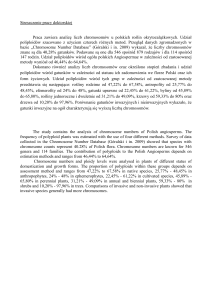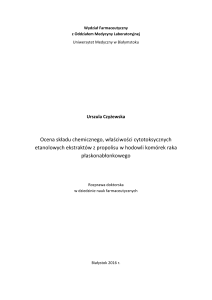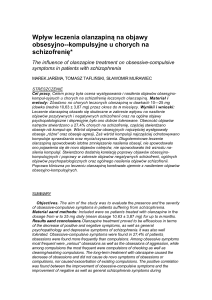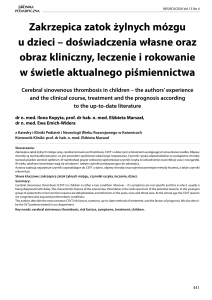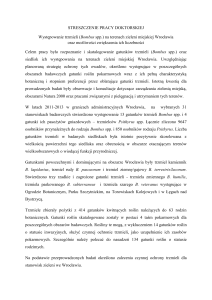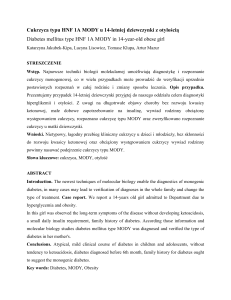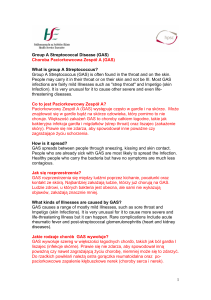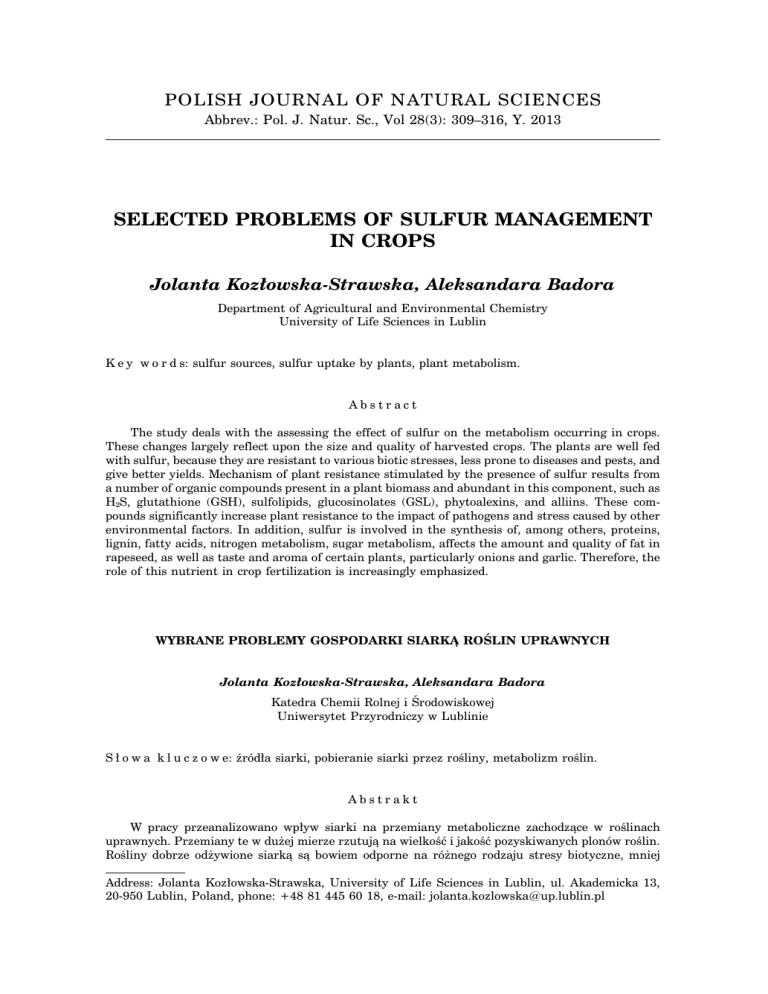
POLISH JOURNAL OF NATURAL SCIENCES
Abbrev.: Pol. J. Natur. Sc., Vol 28(3): 309–316, Y. 2013
SELECTED PROBLEMS OF SULFUR MANAGEMENT
IN CROPS
Jolanta Kozłowska-Strawska, Aleksandara Badora
Department of Agricultural and Environmental Chemistry
University of Life Sciences in Lublin
K e y w o r d s: sulfur sources, sulfur uptake by plants, plant metabolism.
Abstract
The study deals with the assessing the effect of sulfur on the metabolism occurring in crops.
These changes largely reflect upon the size and quality of harvested crops. The plants are well fed
with sulfur, because they are resistant to various biotic stresses, less prone to diseases and pests, and
give better yields. Mechanism of plant resistance stimulated by the presence of sulfur results from
a number of organic compounds present in a plant biomass and abundant in this component, such as
H2S, glutathione (GSH), sulfolipids, glucosinolates (GSL), phytoalexins, and alliins. These compounds significantly increase plant resistance to the impact of pathogens and stress caused by other
environmental factors. In addition, sulfur is involved in the synthesis of, among others, proteins,
lignin, fatty acids, nitrogen metabolism, sugar metabolism, affects the amount and quality of fat in
rapeseed, as well as taste and aroma of certain plants, particularly onions and garlic. Therefore, the
role of this nutrient in crop fertilization is increasingly emphasized.
WYBRANE PROBLEMY GOSPODARKI SIARKĄ ROŚLIN UPRAWNYCH
Jolanta Kozłowska-Strawska, Aleksandara Badora
Katedra Chemii Rolnej i Środowiskowej
Uniwersytet Przyrodniczy w Lublinie
S ł o w a k l u c z o w e: źródła siarki, pobieranie siarki przez rośliny, metabolizm roślin.
Abstrakt
W pracy przeanalizowano wpływ siarki na przemiany metaboliczne zachodzące w roślinach
uprawnych. Przemiany te w dużej mierze rzutują na wielkość i jakość pozyskiwanych plonów roślin.
Rośliny dobrze odżywione siarką są bowiem odporne na różnego rodzaju stresy biotyczne, mniej
Address: Jolanta Kozłowska-Strawska, University of Life Sciences in Lublin, ul. Akademicka 13,
20-950 Lublin, Poland, phone: +48 81 445 60 18, e-mail: [email protected]
310
Jolanta Kozłowska-Strawska, Aleksandra Badora
podatne na choroby i szkodniki i lepiej plonują. Mechanizm odporności roślin stymulowanej przez
siarkę wynika z obecności w biomasie roślinnej wielu związków organicznych zasobnych w ten
składnik, takich jak: H2S, glutation (GSH), sulfolipidy, glukozynolany (GSL), fitoaleksyny oraz
alliiny. Związki te wyraźnie zwiększają odporność roślin na wpływ patogenów oraz stres wywołany
działaniem innych czynników środowiskowych. Dodatkowo siarka bierze udział min. w syntezie
białek, lignin, kwasów tłuszczowych, przemianach związków azotu, metabolizmie cukrów, wpływa na
ilość i jakość tłuszczu w nasionach rzepaku oraz walory smakowe i zapachowe niektórych roślin,
zwłaszcza cebuli i czosnku. Coraz częściej podkreśla się więc rolę tego składnika pokarmowego
w nawożeniu roślin uprawnych.
Introduction
Metabolic changes that occur in plants impinge heavily on the size and
quality of the crop yields. Sulfur is clearly a nutrient, which plays an important
role in plant metabolism. It is a component of many important compounds, the
lack of which causes deterioration of harvested plant material quality and
disorders in humans and animals. Plants well fed with sulfur are more
resistant to biotic stresses, less prone to diseases and, in consequence, give
better yields (BEDNAREK et al. 2008, MOTOWICKA-TERELAK and TERELAK 2000,
PODLEŚNA 2005).
Unfortunately, there are more and more signs of a deepening deficit of this
nutrient in crop production (Table 1).
Table 1
Sulfur pools and fluxes in agricultural land (KACZOR and ZUZAŃSKA 2009)
Amount
[kg S ha–1 rok–1]
Outflows
Amount
[kg S ha–1 rok–1]
Atmosphere
12÷21
uptake by plants
13÷42
Fertilization
0÷26
leaching nutrients
30÷80
Earth water
0÷295
gas losses
0.2÷3
Mineralization
10÷30
–
–
1.5
–
–
Income
Gases
Data published by the Sulfur Institute in Washington suggests that the
global sulfur deficit in 2013 will reach nearly 11.9 million tons. Also, the results
of research conducted by IUNG-PIB in Pulawy clearly show that more than
half of the soil of our country (53%) is characterized by a low abundance of
sulfur available to plants (less than 20 mg S-SO4 kg–1), 26% has an average, and
16% high abundance; the remaining 5% of Polish soils are contaminated due to
Selected Problems of Sulfur...
311
anthropogenic activities. Deficiency of this component in a plant growth
environment affects primarily the cultivation of crops with high demands for
sulfur (GONDEK 2010, MOTOWICKA-TERELAK and TERELAK 2000, WIELEBSKI
2011).
Therefore, the aim of this study was to evaluate the role of sulfur in
metabolic transformations occurring in crops. This assessment based on the
research of literature related to this subject.
Crop requirements for sulfur
The nutritional requirements of crops for sulfur depend largely on the
crop species and the size of harvested crop (GAJ and KLIKOCKA 2011, KACZOR
and ZUZAŃSKA 2009).
Primarily plants from Brassicaceae and Liliaceae families belong to the
group with a particularly high demand for sulfur: rape, mustard, radish,
turnip, onion, and garlic. They uptake 40 or even 80 kg of sulfur from 1 ha
from the average yield (FILIPEK-MAZUR and GONDEK 2005, KOZŁOWSKA-STRAWSKA and KACZOR 2009, SZULC et al. 2000). Another group of plants with
a high demand for sulfur mainly include: alfalfa and clover, which produce
large amounts of protein, as well as corn and beets because of the quantity
of the biomass produced. The last group of plants consists of those
with a relatively small demand for sulfur, which take an average of 12
to 25 kg S ha–1 (grasses, potatoes). In the case of this group of plants, it is
often underlined that although their requirements for sulfur are small, but at
higher levels of fertilization using other nutrients, especially nitrogen and
phosphorus, the demand of plants for sulfur may also increase due to the
increased yield of crops (BARCZAK and NOWAK 2010, FILIPEK-MAZUR and
GONDEK 2005, MCGRATH et al. 1996).
Mechanism of sulfur uptake by crops
Sulfur is taken mainly by roots. Sulfate uptake mechanism can be both
passive and active. Passive process occurs mainly by means of diffusion
consisting in equalizing the concentrations between the external solution and
the so-called apparently free space in the root. Sulfates contained within this
space can be exchanged into other ions or be removed by washing. The
penetration of sulfates within apparently free space occurs relatively rapidly
and generally the balance between the external solution and apparently free
space is achieved after 30 minutes (MARSCHNER 1995).
312
Jolanta Kozłowska-Strawska, Aleksandra Badora
Sulfur active uptake may occur against concentration gradient, wherein
the acquired ions are not washed away, which requires some energy efforts
expended by living cells (MARSCHNER 1995).
Sulfur can also be taken up by plants in the form of SO2. The proportion of
sulfur absorbed from the air in relation to its total content at plants amounts
to 15–30% for well provided plants and more than 50% at plants suffering from
sulfur deficiency (DECHNIK et al. 1990).
Sulfur sources for crops
Undoubtedly minerals containing sulfur in their crystal structures are the
primary source of the element in the soil. Among minerals abundant in sulfur,
the most important are: gypsum, iron sulfides found in the soil under reductive
processes, and hydrotroilite making dark color of some clays and silts.
Sphalerite, chalcopyrite, and cobaltite are also present, yet in smaller quantities. Readily soluble sulfates can be found in dry climate conditions, while
sodium alum and tamarugite in a very dry climate. In agricultural soils
containing pyrite in deeper profiles, iron, sodium, potassium, magnesium
sulfate, and compounds at lower oxidation state such as sulfites, thiosulfates,
pentathionates, and elemental sulfur are often present (MARSKA and WRÓBEL
2000, MOTOWICKA-TERELAK and TERELAK 1998).
Some organic compounds are another very valuable source of sulfur, among
which the following dominate: amino acids, particularly methionine, and
cysteine, the peptides (glutathione), protein, sulfolipids, and vitamins
(thiamine and biotin) (FILIPEK-MAZUR and GONDEK 2005, MARSCHNER 1995).
The sulfur is introduced into the soil along with certain mineral
fertilizers. These fertilizers are divided into two main groups: simple and
complex. The simple fertilizers contain sulfur in the forms directly available
to plants or as elemental sulfur, which must be oxidized in the soil prior
to it is taken up by plants. Complex fertilizers can contain a variety of
chemical forms of sulfur, hence their bioavailability is generally diverse
(ERIKSEN and MORTENSEN 2002, MCGRATH et al. 1996, WIELEBSKI and
WÓJTOWICZ 2000).
Natural fertilizers, especially farmyard manure, is a valuable source of
sulfur, the content of the element varies from 0.3 to 0.6 kg S Mg–1 d.m. of
fertilizer (MARSKA and WRÓBEL 2000, WIELEBSKI 2006).
Sulfur penetrating the soils can also origin from the atmosphere.
Sulfur(IV) oxide, that is a major component of air contamination, can be
absorbed onto the soil surface in the gaseous form and then dissolved and
oxidized in the soil solution. The process is then referred to as dry deposition.
313
Selected Problems of Sulfur...
Sulfur oxides can be also oxidized in the atmosphere forming sulfuric acid and
it is then called wet deposition (ERIKSEN and MORTENSEN 2002, MARSKA and
WRÓBEL 2000).
Sulfur functions in crop metabolism
Sulfur is involved in numerous physiological processes taking place in all
crops. Its deficiency inhibits primarily the protein synthesis. In the absence of
sulfur, plants produce proteins of worse quality, which is associated with
a lower content of essential amino acids such as methionine and cysteine.
In addition, sulfur is a component necessary for the activity of enzymes
responsible for nitrates reduction. Plants grown under the sulfur deficiency,
accumulate non-protein nitrogen forms in their medium: nitrates, amides, and
other compounds, such as ammonia (MARSCHNER 1995).
Moreover, in the absence of sulfur, photosynthetic intensity is lowered, as
well as the decrease in protein synthesis and nucleic acids content, can reach
up to about 50% or more. Sulfur stimulates the synthesis of lignin, fatty acids,
it is a part of vitamin B1 (thiamine) and vitamin H (biotin). It is also involved in
enzymatic reactions responsible for biological nitrogen fixation from the air by
nitrogen-fixing root bacteria, and is a component of some volatile compounds
(aliphatic thioesters, polysulfides, sulfoxides) responsible for the taste and
aroma of certain plants such as onions and garlic (ERIKSEN and MORTENSEN
2002, MARSCHNER 1995).
Sulfur deficiency in plant growth medium also causes disturbances in the
metabolism of sugars. The starch content may be increased up to 2–3-fold,
while reducing the amount of reducing sugars. This is undoubtedly related to
the decrease in the photosynthetic activity of plants, at which chlorosis is the
consequence of the sulfur absence (PARK 1988).
Similar correlations also showed in their study on the effect of sulfur on
quality parameters of spring wheat PODLEŚNA and CACAK-PIETRZAK (2006)
– Table 2.
Table 2
Chemical features of flour in dependence on sulfur fertilization (PODLEŚNA and CACAK-PIETRZAK 2006)
Ash
[% s.m.]
Total protein
[% s.m.]
Gluten
[%]
-S [0 S ha–1]
0.65
14.0
29.1
+S [50 kg S ha–1]
0.64
14.1
29.6
LSD [α = 0.05]
0.010
0.052
r.n.
Income
r.n. – non-significant differences.
314
Jolanta Kozłowska-Strawska, Aleksandra Badora
The use of sulfur is one of the most important factors influencing on the
synthesis and accumulation of glucosinolates in rapeseed (Table 3).
Table 3
Main glucosinolates occurring in cruciferous plants (OLESZEK 1995)
Common name
Occurrence
Synigrine
Brassica nigra
Glukonapine
B. napus
Progoitrine
B. napus
Glukobrassicanapine
B. napus
Glukonapoleipheryne
B. napus
Glukonasturcine
Nasturtium officinalis
Glukotropaeoline
Lepidium sativa
Synalbine
Sinapis alba
Glukobrasicine
B. oleracea
4-OH Glukobrasicine
B. napus
4-OCH3 Glukobrasicine
B. napus
Neoglukobrasicine
B. napus
The mature seeds of rape contain the largest quantities of the following
four alkene glucosinolates: progoitrine, gluconapine, glucobrassicanapine, napoleipherine, and among indole glucosinolates: 4-hydroxyglucobrassicine and
glucobrassicine. Excessive accumulation of glucosinolates in rapeseed is considered as a negative phenomenon, because too high content of these compounds eliminates the use of post-extraction meal as a feed for animals. It is
assumed that about 25–30% of the total sulfur, on average, present in the seed
can be found in glucosinolates. This reduces the nutritional value of the
post-extraction meal, making the taste worse at the same time. Although it is
assumed that glucosinolates are not harmful to animals, but the products of
their enzymatic decomposition due to myrosinase enzyme become toxic. They
mainly cause disturbances in the thyroid, liver, and kidneys functioning. As
permitted in Poland and the EU, total glucosinolate levels in industrial
rapeseed 00, the level of 25 μM per 1 g of dry de-fatted matter is accepted.
However, from the viewpoint of metabolism occurring at plants, glucosinolates
act as a storage of sulfur during its deficit within the plant growth medium
(FIGAS 2009, GAJ and KLIKOCKA 2011, KACZOR and ZUZAŃSKA 2009, MALARZ et
al. 2011).
The role of glucosinolates or their hydrolysis products is also associated
with the defense functions of plants and interactions between Brassicaceae or
Cruciferae plants vs. pests and pathogens. Glucosinolate catabolism products
Selected Problems of Sulfur...
315
exhibit a significant toxicity to a number of pathogenic fungi, bacteria, viruses,
insects, and higher plants. They play functions of repellents, attractants, or
compounds modifying the pest behavior, but also play a role in allelopathic
interactions (GAJ and KLIKOCKA 2011, MAJCHRZAK et al. 2010, PODLEŚNA 2005).
Under conditions of good sulfur nutrition and at the same time in response
to pathogens, a plant mobilizes its specific metabolic mechanism, which is
referred to as sulfur-induced resistance – SIR (Sulfur Induced Resistance). The
mechanism involves sulfur applied in accordance with a planned strategy of
fertilization. Free cysteine resources appearing at plants well supplied with
this nutrient become a factor of the plant resistance, while non-protein
cysteine is a precursor of all relevant compounds containing sulfur and having
a mechanism most probably related to the immunity stimulated by the
component (GAJ and KLIKOCKA 2011).
Mechanism of plant resistance stimulated by the presence of sulfur in the
biomass results from a number of organic compounds abundant in this
component, such as H2S, glutathione (GSH), sulfolipids, glucosinolates (GSL),
phytoalexins, and alliins. These compounds significantly increase the plant
resistance towards the impact of pathogens and stress caused by the action of
other environmental factors. The protective effect of sulfur was found particularly with respect to the black cross, powdery mildew, leaf spot light, and to
a lesser extent, in the case of dry rot in cabbage (GAJ and KLIKOCKA 2011,
MAJCHRZAK et al. 2010, PODLEŚNA 2005).
Summary
The role of sulfur in plant nutrition has gained its importance especially in
the last few years, when a clear deficit of this nutrient in crop production was
found both in Poland and in most European countries.
Sulfur plays a specific role in the plant metabolism. It participates in the
synthesis of proteins, lignin, fatty acids, nitrogen metabolism, sugar metabolism, affects the quantity and quality of fat in the seeds of oilseed plants, taste
and flavor of certain plants and participates in plant defense mechanisms.
Given the functions that this element plays in a plant life, it can be counted
into the group of nutrients determining both the size and quality of harvested
crops. Therefore, sulfur, besides nitrogen, phosphorus, and potassium, should
be included in the group of nutrients regularly supplied to grown plants within
the fertilization plan.
Translated by MAREK SZLACHTA
Accepted for print 6.09.2013
316
Jolanta Kozłowska-Strawska, Aleksandra Badora
References
BARCZAK B., NOWAK K. 2010. Oddziaływanie dawki i formy siarki na plonowanie oraz zawartość i plon
białka ziarna owsa odmiany Komes. Fragm. Agron., 27(1): 14–20.
BEDNAREK W., TKACZYK P., DRESLER S. 2008. Siarka w niektórych roślinach uprawnych Lubelszczyzny.
Acta Agrophys., 11(3): 575–587.
DECHNIK I., GLIŃSKI J., KACZOR A., KERN H. 1990. Rozpoznanie wpływu kwaśnych deszczy na glebę
i roślinę. Probl. Agrofiz., 60: 3–70.
ERIKSEN J., MORTENSEN J.V. 2002. Effect of timing of sulphur application on yield, S-uptake and
quality of barley. Plant and Soil, 242: 283–289.
FIGAS A. 2009. Wpływ sposobu nawożenia siarką i dolistnej aplikacji magnezu i boru na plonowanie
rzepaku jarego oraz zawartość glukozynolanów w nasionach. Fragm. Agron., 26(1): 25–33.
FILIPEK-MAZUR B., GONDEK K. 2005. Plonowanie i zawartość siarki w gorczycy białej jako efekt
stosowania wieloskładnikowych nawozów zawierających siarkę. Acta Agrophys., 6(2): 343–351.
GAJ R., KLIKOCKA H. 2011. Wielofunkcyjne działanie siarki w roślinie – od żywienia do ochrony. Prog.
Plant Protection/Post. Ochr. Roślin, 51(1): 33–44.
GONDEK K. 2010. Ocena wpływu siarki wprowadzonej do gleby z nawożeniem mineralnym oraz
odpadem po produkcji siarczanu magnezu na jej zawartość w pszenicy (Triticum aestivum L.).
Acta Agrophys., 15(2): 269–280.
KACZOR A., ZUZAŃSKA J. 2009. Znaczenie siarki w rolnictwie. Chemia. Dydaktyka. Ekologia. Metrologia, 14(1–2): 69–78.
KOZŁOWSKA-STRAWSKA J., KACZOR A. 2009. Sulphur as a deficient element in agriculture – its influence
on yield and on the quality of plants materials. Ecol. Chem. Eng. A, 16(1–2): 9–19.
MAJCHRZAK B., KUROWSKI T.P., JANKOWSKI K. 2010. Wpływ przedplonów nawożonych siarką na
zdrowotność korzeni pszenicy ozimej. Prog. Plant Protection/Post. Ochr. Roślin, 50(2): 927–930.
MALARZ W., KOZAK M., KOTECKI A. 2011. Wpływ wiosennego nawożenia różnymi nawozami siarkowymi
na wysokość i jakość plonu nasion rzepaku ozimego odmiany ES Saphir. Rośliny Oleiste – Oilseed
Crops, 32: 107–115.
MARSCHNER H. 1995. Mineral nutrition of higher plants (sec. edit.). Cambridge, pp. 889.
MARSKA E., WRÓBEL J. 2000. Znaczenie siarki dla roślin uprawnych. Folia Univ. Agric. Stein. 204
Agricultura, 81: 69–76.
MCGRATH S.P., ZHAO F.J., WITHERS P.J.A. 1996. Development of sulphur deficiency in crops and its
treatment. The Fertiliser Society, London, pp. 3–47.
MOTOWICKA-TERELAK T., TERELAK H. 1998. Siarka w glebach Polski – stan i zagrożenia. PIOŚ,
Biblioteka Monitoringu Środowiska, Warszawa, pp. 106.
MOTOWICKA-TERELAK T., TERELAK H. 2000. Siarka w glebach i roślinach Polski. Folia Univ. Agric.
Stein. 204 Agricultura, 81: 7–16.
OLESZEK W. 1995. Glukozynolany – występowanie i znaczenie ekologiczne. Wiad Bot., 39(1/2): 49–58.
PARK H. 1988. Physiological role of sulphur in plants. International symposium on sulphur for Korean
agriculture, Seoul, Korea. Proc., pp. 77–93.
PODLEŚNA A. 2005. Nawożenie siarką jako czynnik kształtujący metabolizm roślin uprawnych i jakość
płodów rolnych. Pam. Puł., 139: 161–174.
PODLEŚNA A., CACAK-PIETRZAK G. 2006. Kształtowanie plonu oraz parametrów przemiałowych
i wypiekowych pszenicy jarej poprzez nawożenie azotem i siarką. Pam. Puł., 142: 381–392.
SZULC P., PIOTROWSKI R., DROZDOWSKA L., GACA J. 2000. Wpływ nawożenia siarką na plon i akumulację
związków siarki w nasionach rzepaku jarego odmiany Star. Folia Univ. Agric. Stein. 204
Agricultura, 81: 157–162.
WIELEBSKI F. 2006. Nawożenie różnych typów odmian rzepaku ozimego siarką w zróżnicowanych
warunkach glebowych. I. Wpływ na plon i elementy struktury plonu nasion. Rośliny Oleiste
– Oilseed Crops, 27(1): 265–282.
WIELEBSKI F. 2011. Wpływ nawożenia siarką w warunkach stosowania zróżnicowanych dawek azotu
na skład chemiczny nasion różnych typów odmian rzepaku ozimego. Rośliny Oleiste – Oilseed
Crops, 32: 79–95.
WIELEBSKI F., WÓJTOWICZ M. 2000. Problemy nawożenia rzepaku siarką w Polsce i na świecie. Rośliny
Oleiste – Oilseed Crops, 21(2): 449–463.

